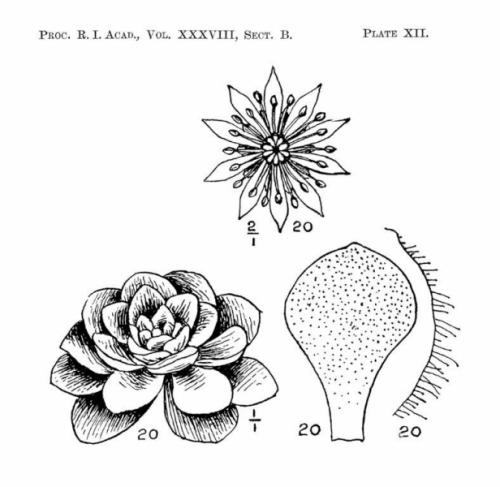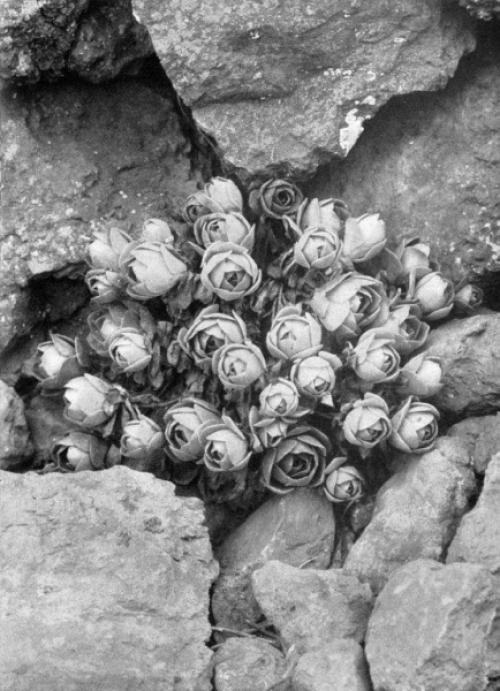x sanctisebastiani Bramwell & Rowley, 1973
Par: Aeonium saundersii Bolle × Aeonium subplanum Praeger
[or Aeonium canariense (L.) Webb & Berthel. when A. subplanum is considered to be included in A. canariense. (Art. H.5.2)]
Sempervivum canariense L. × Sempervivum saundersii (Bolle) H.Christ, Praeger, Notes on Canarian and Madeiran Semperviva, Transactions of the Botanical Society of Edinburgh 29: 200. 1925 (without description).
Aeonium saundersii Bolle × Aeonium subplanum Praeger, in Praeger, Semperviva of the Canary Islands area, Proceedings of the Royal Irish Academy 38 Sect.B (1): 480, t.12, fig. 20. (24 Sep) 1929.
Sempervivum canariense var. latifolium Burchard × Sempervivum saundersii (Bolle) H.Christ, in Burchard, Beiträge zur Ökologie und Biologie der Kanarenpflanzen, Bibliotheca Botanica 98: 119, 138, t.34. 1929.
Aeonium ×sanctisebastiani Bramwell & G.D.Rowley, in Jacobsen & Rowley, Some name changes in succulent plants, Part V., National Cactus and Succulent Journal 28: 5. (Mar) 1973 ("×sanctisebastianii").
Etym: Named for San Sebastián de la Gomera, municipal capital of La Gomera. Having been latinised, the genitive has only one i. The authors chose not to hyphenate the separate elements of the name so that is to be maintained.
T: Islas Canarias, La Gomera, in the barranca below La Laja, c.8km WNW of San Sebastián de la Gomera; R. Lloyd Praeger.
HT: Sketch of a rosette, leaf & flower, in Praeger, Semperviva of the Canary Islands area, Proceedings of the Royal Irish Academy 38 Sect.B (1): 480, t.12, fig. 20. (24 Sep) 1929. Autotype (Art. 9.1). The only included element.
Obs: In Bañares (Vieraea 43: 195, 2015), Art. 40.1 (lack of type) is cited as a reason for a superfluous reneotypification, but Praeger's sketch was referred to in the validation by Bramwell & Rowley as “1929: 480”, the place of publication of the protologue description, where there is also a reference to the illustration as “Plate XII, fig. 20”. This is the only included element of Praeger's description and thus also of Bramwell & Rowley's validation.
Description (according to Praeger, An Account of the Sempervivum Group, 1932) :
Shrubby-herbaceous, branched.
Branches short, rather slender, clothed with brown dead leaves.
Rosettes open, rather dense, 5 - 8 cm across.
Leaves suberect, fresh green, obovate-spathulate, 3 - 4 x 2 - 3 cm, subsessile, subviscid, glandular-pubescent, broadly cuneate at apex, margin glandular-pubescent.
Inflorescence and flowers intermediate.
The plant, unlike saundersii, which is twiggy and shrubby, forms a low mound. The dead brown leaves which clothe the stem are easily detached, unlike the persistent blackish ones of subplanum ; those of saundersii are not persistent. The leaves never form a closed bud as in saundersii, but they are much more erect than in subplanum. Flowering branch twice as long as in saundersii. Petals 11 - 12 as in the canariense section.

Aeonium ×sanctisebastiani (A. saundersii × subplanum) HT image from Praeger, Semperviva of the Canary Islands area, Proceedings of the Royal Irish Academy 38 Sect.B (1): 480, t.12, fig. 20. (24 Sep) 1929. 37

Aeonium ×sanctisebastiani from Burchard, Beiträge zur Ökologie und Biologie der Kanarenpflanzen, Bibliotheca Botanica 98: 119, 138, t.34. 1929. 37